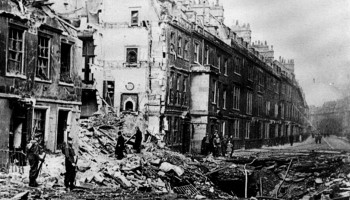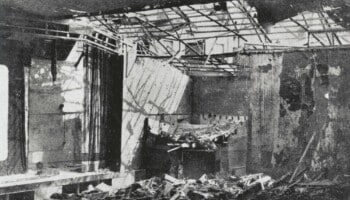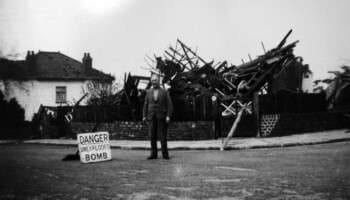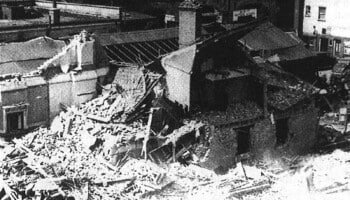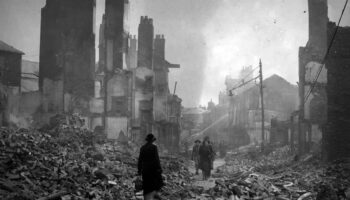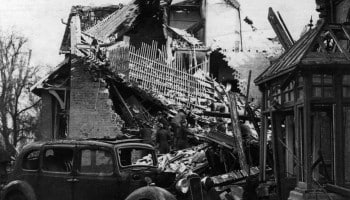Home » Resources » UXO City Guides »
UXO City Guide
Home Office Bombing Statistics for Newcastle
Record of German Ordnance dropped on the County Borough of Newcastle
High Explosive Bombs (All types)
152
Parachute Mines
1
Oil Bombs
0
Phosphorus Bombs
0
Fire Pots
0
Pilotless Aircraft (V-1)
0
Long-range Rocket Bombs (V-2)
0
Weapons Total
153
Area Acreage
11,094
Number of items per 1,000 acres
13.8
Why was Newcastle targeted and bombed in WWII
Based on the northern bank of the River Tyne, Newcastle’s history is that of a large shipbuilding Dockyard1 and supplier of coal2 and other important materials. By the start of WWII, the heavy industry of Newcastle was centred on the production of ships and armaments.
The importance of the dockyards and industry was directly observed by Nazi Germany, with Adolf Hitler specifically mentioning the town in his ‘Directive No 9’. Hitler identified Newcastle’s importance in the supply of coal as a major target for early Luftwaffe raids.
Luftwaffe mapping of the city indicates a particular focus on targets along the River Tyne, with areas such as the Spillers Factory and ship building yards both highlighted in the images below. Additionally, local railway stations were also targeted, likely due to the major rail connections between Newcastle and Scotland and the importance of trains to transport coal across the country.
After a shift in Luftwaffe bombing strategy, they stopped targeting areas only associated with military or industrial imports and started what is now known as the ‘Blitz’ – the targeting of civilian areas of city in order to subvert morale.
This led to the continual targeting of both the dockyards and city’s residential areas. The River Tyne allowed Luftwaffe bombers to easily navigate into the city and unleash their payload before returning to the coast. Luftwaffe aircraft had only a short flight from occupied countries such as Denmark and the Netherlands.
This relentless bombing strategy caused extensive damage to not only the dockyards, but also the city’s residential areas.
Home Office Bombing Statistics for Newcastle
Despite the prevalence of Newcastle as a Luftwaffe target from the outbreak of the war, the County Borough of Newcastle overall was only subjected to a Low density of bombing, with 152 High Explosive bombs and a single parachute mine dropped across the borough – a density of 13.8 items recorded per 1,000 acres.
This low density may be explained due to the lack of a single central area of industry within Newcastle, due to its many ports, factories and areas of industry spread across the Tyne – in areas such as South Shields, Tynemouth and the Port of Tyne itself.
Major Bombing Raids in Newcastle
The so-called ‘Newcastle Blitz’ is stated to have started in July 1940 and ended in December 19413. During this period multiple raids where carried-out on the city and its surroundings.
The first major raid on Newcastle took place on 2nd July 1940 and was aimed at the High Level Bridge. 13 people died and 123 were injured. The next major raid was on 25th August 1941, with 47 killed and many residential houses were destroyed.
Of particular note was the raid on 1st September 1941, during which the Manors Goods Station on Kings Manor road was hit, with the resulting fire blazing for a week. It resulted in 50 killed, 211 injured and many houses in the surrounding area were completely destroyed.
The final raid of note was on 29th December 1941, with 9 people killed4. This was one of the last raids of the Newcastle Blitz, as during 1942 much of the Luftwaffe air force were moved from France and the nearby countries of western Europe to take part in the German offensive against Russia.
Can UXO still pose a risk to construction projects in Newcastle?
The primary potential risk from UXO in Newcastle is from items of German Air-delivered Ordnance which failed to function as designed. Approximately 10% of munitions deployed during WWII failed to detonate, and whilst efforts were made during and after the war to locate and make UXBs safe, not all items were discovered. This is evidenced by the regular, on-going discoveries of UXO during construction-related intrusive ground works across the UK – not just in Newcastle.
Occasionally items of British explosive ordnance are also encountered – often associated with WWII defensive measures or Home Guard operations. However, there were few military related facilities in or around the city.
I am about to start a project in Newcastle, what should I do?
Developers and ground workers should consider this potential before intrusive works are planned, through either a Preliminary UXO Risk Assessment or Detailed UXO Risk Assessment. This is the first stage in our UXO risk mitigation strategy and should be undertaken as early in a project lifecycle as possible in accordance with CIRIA C681 guidelines.
It is important that where a viable risk is identified, it is effectively and appropriately mitigated to reduce the risk to as low as reasonably practicable (ALARP). However, it is equally important that UXO risk mitigation measures are not implemented when they are not needed.
While there is certainly potential to encounter UXO during construction projects in Newcastle, it does not mean that UXO will pose a risk to all projects. Just because a site is located in Newcastle does not mean there is automatically a ‘high’ risk of encountering UXO. It really does depend on the specific location of the site being developed.
A well-researched UXO Risk Assessment will take into account location specific factors – was the actual site footprint affected by bombing, what damage was sustained, what was the site used for, how much would it have been accessed, what were the ground conditions present etc.
It should also consider what has happened post-war – how much development has occurred, to what depths have excavations taken place and so on. This will allow an assessment of the likelihood that UXO could have fallen on site, gone unnoticed and potentially still remain in situ.
Recent UXO discoveries in Newcastle
Since the war, many items of UXO have been discovered across multiple cities within the UK, with Newcastle no exception. See the news articles below about UXO incidents and discoveries from national and local press in Newcastle.
1st Line Defence keep up-to-date with relevant and noteworthy UXO-related news stories reported across the UK, and you can browse through these articles using the buttons below.
Get UXO risk mitigation services from a partner you can trust
UXO City Guides
Got a project in Newcastle? Not sure if there is a UXO risk? Need advice but not sure where to start?
If you need general advice about UXO risk mitigation in Newcastle, contact us and we will be happy to help.
Contact Us
* indicates required fields








